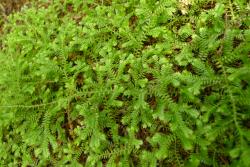Terrestrial (NZ) or rarely epiphytic (not NZ). Plants of varied habit, with an erect or prostrate main stem, giving rise to subsidiary branching systems; lacking a clearly defined rhizome, but erect species sometimes spreading by creeping basal branches; lacking scales. Roots (rhizophores) arising from axils of branches, dichotomously branched, of varying thickness, occurring throughout the length of prostrate stems, or arranged basally to support erect species. Main stems either far-creeping and sometimes scrambling or climbing, much-branched and of indefinite growth; or short-creeping, becoming erect with an unbranched stem giving rise to a frond-like branch-system of finite growth. Leaves spirally arranged, ligulate, undivided, with a single unbranched vein; leaf margins entire to minutely toothed or ciliate; leaves either all similar or of two kinds, those on the basal creeping stems often far apart, those on the ultimate branches closely inserted in four ranks. Strobili terminal on primary or ultimate branches, sometimes inconspicuous. Sporophylls similar to leaves but usually smaller, arranged in four ranks, monomorphic (NZ) or rarely dimorphic (not NZ). Sporangia solitary on adaxial surface of sporophyll, inserted just above the ligule, of two types variously arranged in the strobili. Heterosporous; megasporangia usually containing four megaspores; microsporangia containing more than 100 microspores. Megaspores trilete, pale brown or white, ridged around the equator and trilete scar, variously patterned on the surface, 200-600 µm in diameter; microspores trilete, yellow or orange-brown or red, variously patterned on the surface, 20-60 µm in diameter.
A genus of c. 750 species (Weststrand & Korall 2016b, 2016a).
The range of variation within the genus was summarised by Jermy (1990), who recognised five subgenera. However, Zhou et al. (2015) and Zhou & Zhang (2015) suggested that six subgenera could be recognised based on molecular, macro-morphological, and spore characters. A more recent study involving about one-third of all species has concluded that some of Jermy’s groupings were not monophyletic and that seven subgenera should be recognised based on DNA sequence data and morphology (Weststrand & Korall 2016b, 2016a). In this scheme Selaginella kraussiana belongs to subg. Gymnogynum (P.Beauv.) Weststrand & Korall, and S. martensii and S. moellendorffii to subg. Stachygynandrum (P.Beauv. ex Mirb.) Baker.
The genus was first recorded in New Zealand by Cheeseman (1919), who reported S. kraussiana (as S. denticulata) from the Bay of Islands. This and two other introduced species were subsequently recognised by Brownsey (in Webb et al. 1988).
| 1 | Stems creeping, irregularly branched, prostrate or with the ends of the branches upturned; strobili round in cross-section | 2 |
| Stems erect, forming a frond-like branch system with regular branching; strobili sharply four-angled in cross-section | moellendorffii | |
| 2 | Stems forming a prostrate mat, upturned only at the apices of the branches; branches widely spaced, overlapping only at the stem apices; roots arising throughout the length of the stems; leaves minutely toothed on the margins | kraussiana |
| Stems prostrate to suberect, upturned for about half their length; branches crowded and overlapping; roots arising only in the proximal half of the stem; leaves bearing fine cilia on the margins | martensii |
In New Zealand, species of Selaginella can be distinguished by their small, delicate, ligulate leaves with single unbranched veins. The stems are either prostrate, creeping and irregularly branching, or erect and forming a frond-like branching system. Sporangia are solitary on the adaxial surface of sporophylls, which are aggregated into strobili. Mega- and microspores have very different surface patterns (Large & Braggins 1991).
A large genus found mainly in the tropics but with a few species in the temperate zones of both hemispheres; 18 indigenous species in southern South America (Zuloaga et al. 2008), 10 in southern Africa (Crouch et al. 2011), 10 in Australia (Jermy & Holmes 1998), and perhaps 30 species in the South Pacific region. Three introduced species in New Zealand.
| Category | Number |
|---|---|
| Exotic: Fully Naturalised | 1 |
| Exotic: Casual | 2 |
| Total | 3 |
Base chromosome numbers of x = 7, 8, 9, 10 and 12 have been reported in Selaginella (Jermy 1990).




